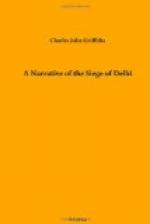A dismal mishap occurred to me in this room. Choosing a comfortable-looking ottoman, I sat down, little dreaming that I had fallen into a trap which would occasion much laughter among my friends for days to come. Feeling a strange moist sensation in a certain portion of my body, I jumped up from the seat, to find, to my horror, that I had plumped down on a quantity of ghee, or clarified butter. A jar of ghee was lying on the floor, and a portion of this horrible mess had been spilt on the seat of the ottoman. I was dressed in white trousers and jacket of the same material, and found, to my intense disgust, that the ghee had left a large patch of colour which no amount of rubbing would eradicate. We were far from our quarters, it was broad daylight, and, to my mortification, I was compelled to walk thus branded through the streets of the city, the laughing-stock of those who saw the plight I was in.
Delhi was celebrated for miniature paintings done on talc, hundreds of which were found at this time. Some were of rare workmanship, portraits of beautiful women and drawings of celebrated buildings, all executed in a style of art peculiar to the craftsmen of that place. We were fortunate, during our search, in coming across the house of one of these artists and disinterring from its concealment a box full of these paintings. They afterwards sold at a good price, and I possessed myself of some twenty of the most beautiful, comprising portraits of Zeenat Mahal, the favourite wife of the King, other ladies of the zenana, and pictures of the Taj and Jama Masjid, besides other mosques throughout India. These oval-shaped miniatures mounted in gold formed most acceptable souvenirs of the city of Delhi, and one in particular, containing the portrait of a lovely Eastern face with head-dress and tiara of diamonds, and strings of pearls round the neck, I was offered L20 for after it had been set in gold by a jeweller at Plymouth. In London, in 1858, there was a great demand for gold ornaments and jewellery from Delhi, so much so that a noted goldsmith offered me the highest price for articles of that description; nor would he at first—till convinced—accept my assurance that I had parted with all my Delhi loot before leaving India.
We were occupied for nearly three weeks in our quest for plunder, engaged in the exciting work almost every day, and seldom failing to find some articles of value. Our last adventure in that line deserves a detailed description, for though the nature of the loot obtained was such that it was useless to appropriate for our own use any of the goods found, still, the value of the plunder increased to a large extent the Delhi prize-money.
We had noticed in the room of the agents piles of kincob, or cloth of gold, worth I fear to say how many rupees a yard. The manufacture of this material was carried on to a great extent in Delhi, there being much demand for the rich and costly fabric among the Princes and nobles of Hindostan. Hitherto in our ramblings through the houses we had only come across a few pieces of this gold brocade; but as luck would have it, on the last day in which I joined N—— in his duties he had received information from a native that a large store of kincob was concealed in the house of a merchant who had dealt in that material.




